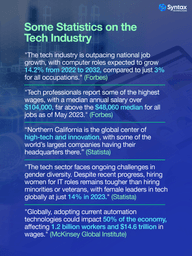The job market today looks nothing like it did a decade ago. Technology isn’t just part of the market; it’s driving it, shaping everything from the types of jobs available to where and how people work. If you’re wondering, “how has technology affected the international job market?” – the answer is both simple and complex. It’s created opportunities, flexibility, and brand-new roles, but it’s also brought challenges, like automation and skill gaps, leaving some people in the dark.
This blog examines how technology has transformed the international job market, creating new opportunities and challenges like job displacement and skill gaps, and explores strategies for adapting to this tech-driven shift.
How Technology Has Changed Job Opportunities Worldwide
Technology hasn’t just added jobs to the global market; it’s redefined how and where we work. Here’s what’s happening on the ground:
- A World Going Digital: Nearly every industry now incorporates tech. From healthcare to education, digital tools and data analytics are reshaping roles and creating demand for a tech-savvy workforce.
- Remote Work Revolution: The tech wave has made remote work mainstream. A software engineer in Kenya can work for a company in Canada. This global access to jobs has broken down old geographic barriers, creating a truly international job market.
- Rise of the Gig Economy: Platforms like Upwork and Fiverr let freelancers work flexibly for clients anywhere in the world. It’s transformed the job market, especially for those who want project-based, flexible work rather than traditional roles.
- AI and Automation: Automation doesn’t just replace jobs; it also creates new ones, especially in fields that require managing, maintaining, or innovating with AI tools.
- The Need for Specialized Skills: The tech boom has created demand for skills like cybersecurity, data science, and cloud computing, making them essential for the future workforce.
Positive Impacts of Technology on the Job Market
- High Demand for Skilled Professionals: With technology rapidly evolving, there’s a significant demand for skilled professionals in areas like cybersecurity, AI, and cloud computing. The question of “how has technology affected the international job market?” often boils down to this – an unending need for skilled people to handle new tech demands.
- New Job Roles and Industries: Tech has generated entirely new careers that didn’t exist a decade ago. Digital marketing, app development, and social media management are just a few examples. These roles give people the chance to enter dynamic fields that align with modern interests and needs.
- Flexible Work Options: Technology has allowed for more flexible work environments, from remote work to freelancing. This flexibility has opened doors for people who otherwise might not have had the opportunity, including parents, people with disabilities, and those in rural areas.
- Global Access to Opportunities: With tech, location isn’t a constraint anymore. People can work with international clients or join global companies from anywhere. The chance to work internationally without relocation is a huge shift that technology has brought to the job market.
- Continuous Learning and Growth: Tech roles often require ongoing learning, pushing professionals to keep evolving. This environment encourages continuous growth, which can be highly motivating for those who enjoy learning new skills and staying relevant.
Articles you may like:
“Top 5 High Paying Tech Jobs to Aim For”
“Top 7 Tech Jobs without Coding Requirement”
“7 Fastest Growing Tech Jobs in USA”
Negative Impacts of Technology on the Job Market
- Job Displacement Due to Automation: Automation has replaced many jobs in manufacturing, retail, and transportation. By 2030, it’s estimated that up to 25% of current jobs could be lost to automation, showing how technology has impacted jobs worldwide.
- Skill Gaps: While tech creates high-demand roles, it also brings skill gaps. Not everyone has access to the training needed to meet these demands, especially in regions where tech education is limited. This gap has left some workers behind in the international job market.
- Inconsistent Job Security in Gig Economy: While platforms like Fiverr and Upwork offer flexibility, they often lack job security. Many gig workers juggle inconsistent income, no healthcare, and no retirement benefits. The gig economy highlights how technology has added new but sometimes unstable job types to the market.
- Increasing Job Pressure: With tech-enabled communication, the boundaries between work and personal life have blurred. Many people feel they’re “always on,” responding to messages even outside working hours, which can lead to burnout and stress.
- Digital Divide and Inequality: Technology has created a divide, where only those with access to digital tools and training can fully benefit from new job opportunities. This divide is evident between countries and even within regions, deepening inequality in the job market.
The automation of tasks across industries is another significant aspect to consider when thinking about how technology has affected the international job market. Let’s dive into that.
The Automation Effect: How Automation is Reshaping the Job Market
Automation is arguably one of the biggest shifts brought by technology. It’s not just affecting low-skilled jobs; it’s also reaching roles in customer service, healthcare diagnostics, and even logistics. Here’s what that looks like:
- Manufacturing: Many factory jobs have been automated, requiring fewer human workers. Machines now handle tasks that used to need manual labor.
- Retail and Customer Service: Self-checkouts and customer service chatbots are replacing traditional roles, especially in large retail chains.
- Transportation and Logistics: With self-driving technology on the rise, the future of truck driving and delivery work may look very different.
Solutions for a Balanced, Tech-Driven Job Market
Technology isn’t going anywhere, so finding ways to address these challenges is essential. Here’s how companies, governments, and workers can adapt:
- Upskilling and Reskilling Programs: Many companies, like Amazon, are funding training for employees to learn new skills relevant to today’s job market. This way, people can transition to tech-driven roles within the same company.
- Public-Private Partnerships: Governments and companies are collaborating to create tech education programs. This approach helps close skill gaps, particularly in areas where tech jobs are scarce but in demand.
- Future-Proofing Education: Schools are beginning to incorporate tech skills into curriculums, teaching coding, digital literacy, and problem-solving to prepare students for tech-driven job markets.
- More Inclusive Gig Platforms: Efforts are underway to create better job security for gig workers, with discussions around providing healthcare and retirement plans to make gig work more sustainable.
- Promoting Digital Equity: Programs that provide affordable internet and digital tools to underserved communities can help close the digital divide, allowing more people to benefit from the tech job market.
Wrapping It Up
So, how has technology affected the international job market? The answer is complex. Technology has opened up new opportunities, brought flexibility, and driven innovation. But it’s also created a gap in skills, left some people behind due to automation, and introduced new challenges in job security and digital inequality.
The key is a balanced approach. With a focus on upskilling, public-private partnerships, education reform, and digital access, we can ensure that technology continues to empower people without leaving anyone out.
At Syntax Technologies, we’re dedicated to supporting this transition by offering courses in some of the most in-demand skills and domains. Our programs are designed to help individuals upskill and reskill, preparing them for the evolving job market and the future of work.


